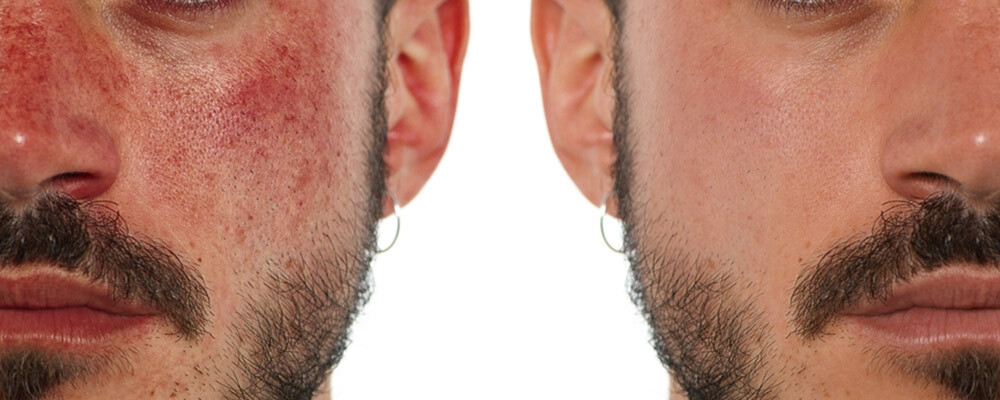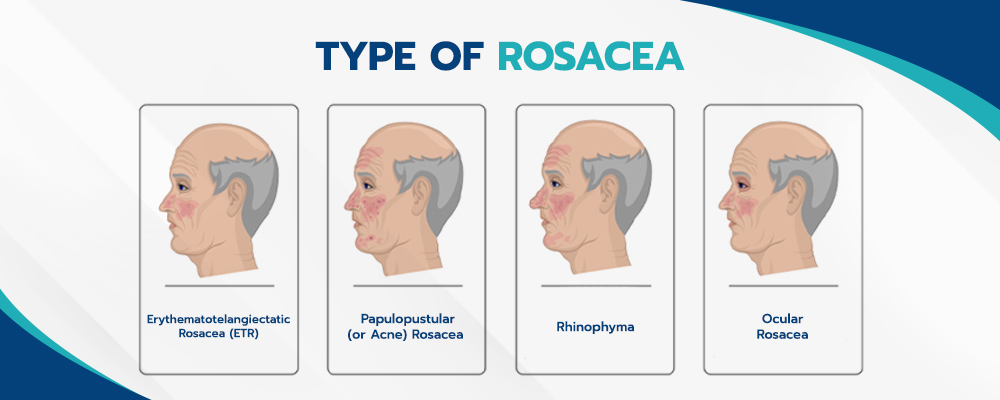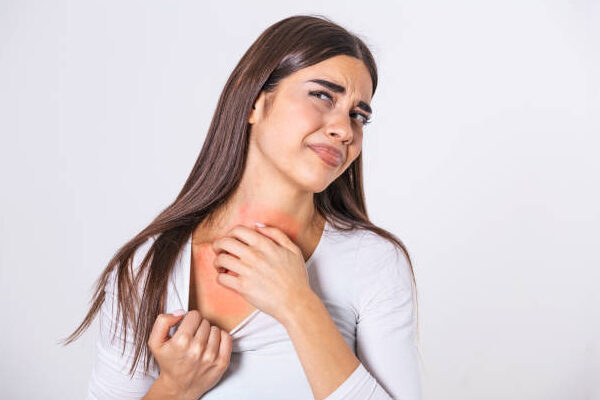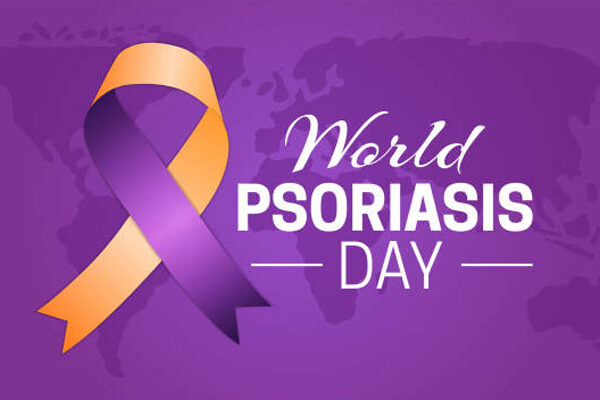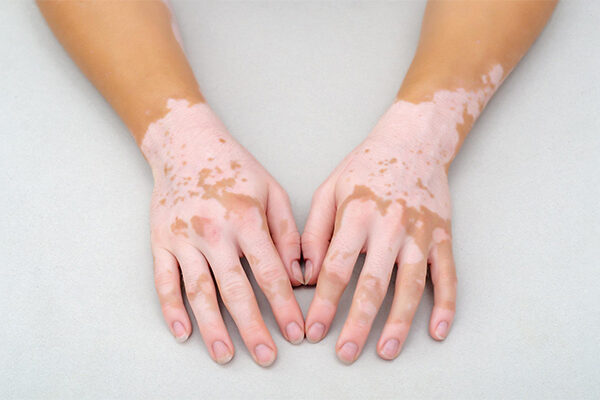Updated on January 25, 2025
Introduction
Rosacea is a chronic inflammatory skin condition that affects the facial skin of individuals any time after they hit the age of 30 years. Although the condition affects all population segments irrespective of their skin color, individuals with lighter skin tones who tend to flush or blush more often are at a higher risk.
Statistically, more than 16 million Americans suffer from rosacea. It is a rare but severe subtype-3 of rosacea, characterized by a bulbous nose in men. While the exact cause of rosacea is unknown, knowledge of it’s: causes, symptoms, and treatments has advanced to the point it can effectively be controlled with medical therapy and lifestyle changes. To advance the course of care, multiple clinical research organizations are conducting patient-centered clinical trials investigating potential alternatives for vulnerable skin conditions including rosacea.
Also read: Lupus Rash vs Rosacea: The True Cause of Facial Redness
What Is Phymatous Rosacea?
Phymatous rosacea is a skin state characterized by a large, red, bumpy, or bulbous nose. It can occur as part of rhinophyma. This severe subtype of rosacea includes persistent facial flushing and erythema alongside excessive facial skin tissue overgrowth. As a result of excess tissue build-up, facial disfigurement occurs. The outcome is usually a large, bumpy mass on the lower third of the nose. It indeed encompasses the nose primarily, however, the chin, cheeks, forehead, ears, and eyelids may also be affected. Unlike other forms of rosacea, the nodules formed near the nostrils can lead to breathing difficulties.
In general, rosacea is a common flushed skin condition (resembles sunburn) primarily involving the central face as flushing or redness of the cheeks, nose, and chin that may come and go. The redness may metastasize to other areas, such as the forehead, neck, and chest.
Rhinophyma on the contrary is a condition categorized as a subtype 3 rosacea. It progresses gradually over several years and is thought to be a result of poorly treated or untreated rosacea. In addition to the disfigurement, subtype 3 rosacea can harm a person’s mental and emotional health.
Also read: Rosacea vs Eczema
Types of Rosacea
There are four types of rosacea:
- Erythematotelangiectatic Rosacea (ETR): is characterized by facial redness, flushing, and visible blood vessels.
- Papulopustular (or Acne) Rosacea: involves acne-like breakouts and commonly affects middle-aged women.
- Rhinophyma: is a rare form resulting in thickening of the skin on the nose, typically seen in men and often accompanied by another subtype of rosacea.
- Ocular Rosacea: focuses on symptoms around the eye area.
Symptoms of Phymatous Rosacea
Rhinophyma or bulbous nose usually occurs in more severe cases of rosacea. It is a progressive condition in which the nose develops a rough, pebbly texture and the skin may become bumpy or even. Moreover, it is believed to be a result of chronic inflammation and an overgrowth of sebaceous glands in the skin.
Following are the symptoms in the less severe stages of rosacea or other subtypes of rosacea:
- Random facial flushing
- Red, blotchy areas centered on the face
- Bumps and pimples (mistaken for acne)
- Telangiectasia (swelling of tiny blood vessels in the nose and cheeks)
- Hypersensitive skin
- Burning, gritty eyes, along with conjunctivitis in about 50% of patients
- Blepharitis (inflammation of the eyelid)
What Causes Phymatous Rosacea?
Likewise, for other forms of rosacea, the exact cause of phymatous rosacea remains unknown. Some studies suggest inflammation to be the root cause of the skin condition. The inflammatory process initiated by a combination of neurovascular dysregulation and the innate immune system appears to be the major culprit for persistent facial flushing in rosacea
In the case of rosacea, individuals may also notice the:
- The presence of numerous sebaceous glands
- Enlarged skin pores
- Reddish skin tone
- Yellowish, waxy-looking nose
Some people come to believe the stigma of heavy alcohol consumption as a risk factor linked to rhinophyma and therefore use the names “whiskey nose,” “rum nose,” and “drinker’s nose” to describe the condition. It was once believed to be caused by alcohol consumption, but new research disagrees with the existing theory.
Risk Factors for Phymatous Rosacea
Several risk factors may increase an individual’s likelihood of developing phymatous rosacea. These risk factors include:
- Gender: Phymatous rosacea is more common in men than in women
- Age: The condition usually develops after the initial stages of rosacea, which typically happen between the ages of 25 and 50
- Genetics: There may be a genetic component to the condition as it often runs in families
- Chronic Inflammation: Persistent inflammation, such as that caused by untreated rosacea can lead to the development of rosacea
- Cigarette Smoking: Smoking has also been linked to an increased risk of developing rosacea
- Sunlight: Prolonged exposure to sunlight exacerbates rosacea symptoms and increases the risk of developing rosacea
- Occupational Hazards: Occupational hazards such as exposure to heat or chemicals are uncommon risk factors involved in its development
Triggers of Phymatous Rosacea
Rhinophyma may be triggered in response to factors capable of increasing blood flow to the skin’s surface. A list of triggering factors that aggravate rosacea include:
- Hot foods and beverages
- Eating spicy foods
- Caffeine consumption
- Extreme weather change
- Prolonged exposure to sunlight
- Emotional outburst
- Strenuous exercise
- Anxiety
Treatment Options for Phymatous Rosacea
To the individuals finding the best possible plan covering every aspect of phymatous rosacea treatments consulting the right skin specialist for a detailed overview is essential. The goal of the treatment regime prescribed by any practitioner aims to slow down the progression of symptoms rather than reverse the damage that has already been done. Depending on the severity of the disfigurement the treatment options used are:
- Oral Medications: In severe cases of rosacea, oral medications aren’t the best choice of treatment. However, oral medications used to manage the less severe forms of the disease include isotretinoin, metronidazole, tetracycline, erythromycin, and minocycline.
- Surgical Procedures: Surgical intervention is thought of as the best treatment for correcting facial disfigurement in phymatous rosacea. The commonly performed surgery types include dermabrasion, CO2 laser, scalpel excision, electro-surgery, and cryo-surgery. Not only do the patients respond well to surgery but the downtime following surgery is also minimal.
- Lifestyle Changes: To effectively manage rosacea symptoms over the long term, it’s crucial to make certain lifestyle changes. If you observe flare-ups in harsh weather, after consuming alcohol or eating spicy foods, consider reducing your exposure to these elements. Over time, this approach can lead to a reduction in flare-ups and overall symptoms.
Also read: Rosacea Treatment & More
Skincare for Phymatous Rosacea
It is always best to follow a preventive regime with all types of rosacea to prevent worsening. Here are some of the useful tips that individuals struggling with rosacea can incorporate to avoid progression:
- Wear sunscreen (SPF 50+) every day that has zinc oxide or titanium dioxide in its ingredient list
- Look for paraben and sulfate-free hypo-allergic moisturizers
- Minimize exposure to triggers to avoid flare-ups
Outlook of Phymatous Rosacea: Causes, Symptoms, and Treatments
The condition although uncommon can disfigure your facial features. Since facial disfigurement is the most prominent feature of phymatous rosacea, it has a strong negative impact on one’s mental health. It is, however, important to enlighten yourself and others about the rosacea: causes, symptoms, and treatments to remove social stigmas around the disorder.
Also read: Rosacea fulminans: An Uncommon Presentation of Rosacea

